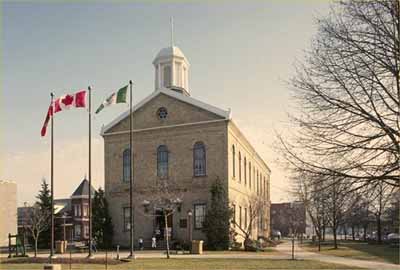Old Woodstock Town Hall National Historic Site of Canada
Woodstock, Ontario

General view
(© Parks Canada Agency / Agence Parcs Canada, 1990.)
Address :
466 Dundas Street (corner of Finkle St.), Woodstock, Ontario
Recognition Statute:
Historic Sites and Monuments Act (R.S.C., 1985, c. H-4)
Designation Date:
1955-05-10
Dates:
-
1853 to 1853
(Construction)
-
1865 to 1865
(Significant)
-
1870 to 1870
(Significant)
Event, Person, Organization:
-
Anton Groble
(Architect)
-
David White
(Builder)
-
William P. Dixon
(Builder)
-
William McKay
(Builder)
Other Name(s):
-
Old Woodstock Town Hall
(Designation Name)
-
Oxford Museum
(Other Name)
-
Woodstock Museum
(Other Name)
Research Report Number:
1955, 1992-016
Plaque(s)
Existing plaque: Old Town Hall (now the Oxford County Museum) 466 Dundas Street (corner of Finkle St.), Woodstock, Ontario
Constructed in 1853, this building was for over a hundred years the centre of municipal and social life in Woodstock. It housed the local government and also served at various times as public market, fire hall, police department, court house, and opera hall. The design is a particularly fine example of colonial adaptation from British models of the period. Although its lines are basically 18th-century Palladian, exterior details such as round-headed windows with heavy surrounds reflect contemporary Italianate Revival influences.
Description of Historic Place
The Old Woodstock Town Hall is a two-storey, buff-brick, Italianate Revival-style town hall building, built in 1853. The Old Town Hall is prominently located at the head of a grassed square, in the heart of the city of Woodstock. The formal recognition consists of the building on its footprint as it existed in 1999.
Heritage Value
The Old Woodstock Town Hall was designated a national historic site of Canada in 1955 because it is a fine example of a colonial adaptation of a British town hall, and because of its long association with the political and social life of Oxford County.
The heritage value of this site resides in its form, materials and functional design. It is an early, extant example of a mid-19th century Ontario town hall. Originally built as a combined town hall and market house, it was one of many combined-function mid-19th century municipal buildings built in Upper Canada. Its tall, two-storey form, classically inspired, multi-functional design, and roof-top cupola are typical of mid-19th century town hall architecture. The Old Woodstock Town Hall's classical proportions and Italianate Revival detailing reflect the adaptation of British architectural trends to the needs and economic limitations of Upper Canada. The building retains a significant amount of its original interior layout and finishes and is likely the most intact of this style of combined-function town halls in Ontario.
The Old Woodstock Town Hall's multiple use design reflects the changing responsibilities of Ontario municipalities over the latter half of the 19th century. Originally designed to provide market space on the ground floor and a meeting hall and mayor’s office on the upper floor, it also served at various times as a concert and lecture hall, dance hall, opera house, fire station, police station, assize court, council hall, and municipal offices. In 1865 a fire hall was added to the rear of the building. In 1870, the market was moved elsewhere, a council chamber and municipal offices were created on the main floor, and the upper floor was extended to create a large assembly hall for social events and public entertainments. A third extension was added in 1877, but later demolished. The building was used for municipal and community purposes for over a hundred years, before being converted to a museum in 1968. In 1994, the building was restored and a fourth extension was added on the footprint of the third to accommodate elevators and washrooms.
Sources: Historic Sites and Monuments Board of Canada, Minutes, May 1955 and May 1972; Parks Canada, Woodstock Town Hall National Historic Site of Canada Commemorative Integrity Statement, April 1999.
Character-Defining Elements
Key elements which relate to the heritage value of the Old Woodstock Town Hall include: its location at the heart of the town; its setback from the street and its relationship to the open square in front of the building; its form, consisting of a rectangular, two-storey, gable-roofed building with a roof-top cupola; its Italianate Revival style design evident in its regular and symmetrical arrangement of openings and elements, its strong vertical orientation, classically inspired detailing such as the pediment with circular window, the domed cupola with colonettes, tall, round-headed windows and doors with stone voussoirs, stone lintels over the main floor windows, and corner quoins; elements related to its municipal function, including the municipal coat of arms over the front entrance; its exterior materials, consisting of buff-brick walls, stone detailing and a stone foundation surviving elements of the interior layout dating to its reconfiguration in the 1870s, including the main floor council chamber, the mayor’s and clerk’s offices, the vaults and the second-storey entertainment hall; surviving original and early interior detailing and finishes, including flooring in the front hall, council chambers and mayor’s office, doors, hardware, wainscoting and baseboards; council room furnishing, installed in 1879, including a horseshoe table and council chairs, witness benches, the mayor’s podium and chair, and two recorders’ desks and chairs; potential archaeological remains relating to the construction of the town hall and its additions.